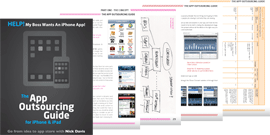If you are planning on offering advertising or sponsorship opportunities in your app, it is important to clear up as early as possible exactly how they will be incorporated.You should also mark on your Functionality List any areas where advertising or sponsorship is likely to play a part including:
- The approximate size of any sponsorship on the page including what should appear (text, logos or other images, if known);
- The type, size and position in the app of any banner ads (and the ad network they will be coming from, if known).
You may feel this is a lot to clear up at an early stage but it is important from a design point of view to figure out exactly how you’re going to incorporate sponsorship or advertising early on.Try to ‘bolt it in’ later and it is likely to mess-up the design or require re-working things at the very least.The inclusion of sponsorship and advertising will almost always look more natural if it is built into the design right from the start.
In the case of sponsorship I also recommended providing detailed mock-ups (and, if necessary, explanations of how they will work) to sponsors as early as possible so you can get sign-off. Changes later in the process are likely to be time consuming and expensive. A simple selection of JPEG (.jpg) mock-ups and a bullet point email explaining the following points should be enough:
- What pages of the app their sponsorship will appear on;
- Which parts of the app they will be able to change and how often (for example, you might give the sponsor a page where they can promote their forthcoming list of events, which they could then send you an update for every month);
- The amount of words (if limited), number of images and (approximate – if you don’t know exactly yet) image dimensions allowed in each area;
- Finally you should agree how updates will be sent.
Sponsor areas – a word of caution
One thing you will need to make sure of (and factor in) if you are allowing sponsors to update areas on the app is: how exactly those updates will happen.This is where you will need to think a little more technically about your app.
On a standard ‘static’ app most sections and content on it cannot be updated remotely. That means if your sponsor suddenly wants to change the logo or the wording on a particular page: tough.
The only way to do this on a standard ‘static’ app then would be to instruct your supplier/developers to make a change to the code and then re-submit it to Apple. If approved Apple will update your app on the App Store but your app will not instantly update for all your users (they will have to go on the App Store and be prompted to do so first). Furthermore, although most users will update their apps eventually, some may take their time and a tiny minority may never do so at all.You can understand then, that this does not help much when you have a sponsor suddenly screaming at you for a change!
Now there’s nothing wrong with this approach if you aren’t going to ever allow your sponsor to make changes on the fly (or don’t anticipate a change of sponsor for a long period). If allowing a sponsor to make updates to the app is likely to ‘add value’ though (helping you to land a bigger sponsor or bring in more revenue from your current partner) then it may be something to consider.
If this is the case then a ‘hybrid’ app is probably going to be the way forward for you.This simply means that on certain parts of the app the content will come from a feed or web page but still display within the app itself.The downside of this is that pulling in anything from outside your app like this will usually rely on your user having web access either through their mobile provider or WiFi connection.
As you can see there are pro’s and con’s to both approaches. Perhaps it will be easier for you to offer your sponsor a standard package that doesn’t change for the lifetime of the app. If you think there’s more value in offering the sponsor some ‘interactivity’ and a chance to include some of their own content though, then a hybrid app may be the right choice. Whatever that choice is though you should go into it with your eyes open and making sure your sponsor (and sales colleagues!) clearly understand what they will and won’t be able to do in the app after launch (there is no need to get overly technical just explain what they can and can’t change).
If you are not sure what to do at this stage, then don’t offer any interactivity to your sponsor now (if pushed, just tell them you will clarify it later) and instead discuss it with your app developer as early as possible so you can better understand what your choices are.Your developer will then be able to explain the options to you (and the impact of each choice) which you can then relay back to your sponsor, should you wish.
